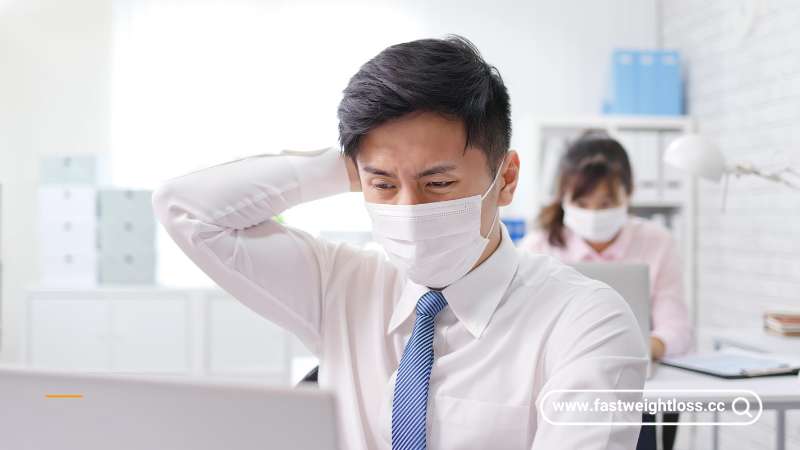Employees should wear masks during respiratory illness season to protect their health and prevent the spread of infections among coworkers. As the season for respiratory illnesses approaches, it is important for employees to take necessary precautions, including wearing masks, to minimize the risk of respiratory infections in the workplace.
By wearing masks, employees can create a barrier against airborne infectious particles, reducing the chance of contracting or spreading illnesses such as the flu, common cold, or COVID-19. This proactive measure promotes a safer and healthier work environment for everyone, safeguarding both individual well-being and overall productivity.
Importance Of Masking Up
The importance of masking up during respiratory illness season cannot be emphasized enough. With the spread of highly contagious viruses, such as the flu or the common cold, it is crucial for employees to take preventive measures to protect their health and the health of their colleagues. Masking up not only helps in preventing the spread of respiratory illnesses but also ensures the overall well-being of employees, reducing the impact on productivity and business operations.
Preventing The Spread Of Respiratory Illnesses
When employees wear masks, they create a physical barrier that helps prevent the transmission of respiratory droplets that may contain viruses. Respiratory illnesses, like the flu, are known to spread through the air when an infected person coughs, sneezes, or talks. Without proper protection, these droplets can easily enter the respiratory system of others, causing widespread illness. By masking up, employees decrease the likelihood of transferring these harmful particles to their coworkers, reducing the risk of mass outbreaks within the workplace.
Protecting The Health And Well-being Of Employees
Masking up is not only a responsible measure but also an act of care towards oneself and others. By wearing masks, employees actively prioritize their own health and well-being, as well as the health of their colleagues. A single infected individual can wreak havoc on an entire team, leading to absenteeism, decreased productivity, and a negative impact on overall business operations. By taking precautionary measures and masking up, employees actively contribute to maintaining a healthy work environment.
Reducing The Overall Impact On Productivity And Business Operations
When respiratory illnesses spread among employees, it can create a domino effect, shifting the entire focus from work to health concerns. Masking up significantly reduces the chances of widespread illness within the workplace, minimizing the impact on productivity and the ability to deliver tasks effectively. By taking preventive measures, such as wearing masks, employees not only protect themselves but also ensure that business operations continue smoothly, minimizing disruptions and maintaining a steady workflow.
In conclusion, the importance of employees masking up during respiratory illness season cannot be ignored. By preventing the spread of respiratory illnesses, protecting the health and well-being of employees, and reducing the overall impact on productivity and business operations, employees play a crucial role in creating a healthy and thriving work environment. Masking up is a simple yet effective measure that should be embraced by all, promoting a culture of collective responsibility and safeguarding the success of the company.
Choosing The Right Masks
Welcome to the essential guide on choosing the right masks during the respiratory illness season. As the colder months approach, it becomes increasingly important for employees to protect themselves and others from the spread of respiratory illnesses. Masks play a crucial role in preventing transmission, but with so many options available, it can be overwhelming to know which one is the most suitable. In this article, we will provide an overview of the different types of masks available, emphasizing the significance of proper fit and seal to ensure maximum effectiveness.
Understanding Different Types Of Masks Available
Before deciding on the appropriate mask, it’s essential to understand the various options out there. Here are the key types of masks commonly used:
N95 Masks For High-risk Environments
N95 masks, also known as particulate respirators, provide the highest level of protection against airborne particles in high-risk environments. These masks are designed to filter out 95% of airborne particles, including viral particles, making them a top choice for healthcare settings or occupations with a high risk of exposure. N95 masks are lightweight, disposable, and feature a close-fitting design to ensure a secure seal. This seal is crucial for preventing unfiltered air from entering the mask and bypassing the filtration system.
Keep in mind that N95 masks require fit testing to ensure a proper seal and should only be worn by individuals who have been trained in their use.
Surgical Masks For General Use
Surgical masks, also known as medical or procedure masks, are commonly used in healthcare settings as well as public environments during respiratory illness seasons. These masks are primarily intended to protect others from droplets expelled by the wearer. Surgical masks are loose-fitting and offer less filtration compared to N95 masks. However, they still provide a substantial level of protection against respiratory droplets, which are a primary mode of transmission for many respiratory illnesses.
Surgical masks are comfortable to wear and are usually available in various colors and styles. They provide a cost-effective solution, making them suitable for general use in non-high-risk environments.
Importance Of Proper Fit And Seal
No matter which type of mask you choose, ensuring a proper fit and seal is critical for optimal protection. A mask that doesn’t fit snugly on the face can allow unfiltered air to enter, reducing its effectiveness. Factors like a secure nose clip, adjustable ear loops or headbands, and a contoured shape all contribute to achieving a proper fit.
It is important to note that facial hair can interfere with the seal of a mask, compromising its effectiveness. Therefore, individuals with significant facial hair may need to consider alternative options or remove the facial hair for a secure fit.
Remember, by choosing the right mask and ensuring a proper fit and seal, employees can actively contribute to reducing the spread of respiratory illnesses and safeguarding the health of themselves and those around them.
Implementing Masking Protocols
During the respiratory illness season, implementing proper masking protocols is crucial to protect the health and well-being of employees. By developing clear guidelines and policies, providing training and education, and ensuring accessibility and availability of masks, companies can create a safe and healthy work environment. Let’s explore each of these aspects in detail:
H3developing Clear Guidelines And Policies For Mask Usage/h3
To ensure the consistent and correct use of masks, it is essential to develop clear guidelines and policies. These guidelines should clearly outline the situations in which masks should be worn, such as in crowded areas, during meetings, or when interacting with customers. By providing specific instructions, employees will have a better understanding of when and where masks are necessary.
Additionally, these guidelines should address the proper handling and disposal of masks. Emphasize the importance of washing hands before and after wearing a mask and disposing of used masks in designated bins. By establishing these protocols, you can help prevent the spread of respiratory illnesses within the workplace.
H3providing Training And Education On Proper Mask Usage/h3
Masks are only effective when used correctly. Therefore, it is crucial to provide comprehensive training and education to all employees on proper mask usage. This can include training sessions or informative videos that explain the correct way to wear, remove, and store masks.
During the training, highlight the importance of a snug fit, covering both the nose and mouth, ensuring no gaps exist. Encourage employees to avoid touching the mask while wearing, as this can compromise its effectiveness. By ensuring employees are knowledgeable about proper mask usage, you can enhance their safety and reduce the risk of respiratory illness transmission.
H3ensuring Accessibility And Availability Of Masks For All Employees/h3
One of the key aspects of implementing mask protocols is to ensure accessibility and availability for all employees. Provide masks to all staff members, regardless of their role or department within the company. This includes full-time employees, part-time employees, and contractors.
Consider establishing designated mask stations or distribution points throughout the workplace, ensuring that employees have easy access to masks whenever needed. Additionally, make sure to stock an ample supply of masks to avoid shortages. By ensuring accessibility and availability, you can promote a culture of mask usage and protect the health of your workforce.
Creating A Culture Of Masking Up
During respiratory illness season, it is crucial for employees to prioritize their health and the well-being of others by wearing masks. Creating a culture of masking up is essential in maintaining a safe and healthy work environment. By encouraging positive attitudes towards masking up, leading by example at all levels of the organization, and regularly communicating the importance of mask usage, companies can foster a culture that prioritizes the health and safety of their employees.
Encouraging Positive Attitudes Towards Masking Up
In order to create a culture of masking up, it is important to encourage positive attitudes towards wearing masks. By highlighting the benefits of mask usage and emphasizing the role it plays in protecting oneself and others, employees can develop a keen understanding of its importance. Additionally, fostering an environment of support and unity where mask wearing is seen as a collective effort in safeguarding each other’s health can further promote positive attitudes towards masking up.
Leading By Example At All Levels Of The Organization
A company’s leadership has a significant influence on shaping the behavior and attitudes of their employees. When leaders consistently model the behavior they expect from their staff, it creates a powerful message that emphasizes the importance of masking up. By visibly wearing masks, adhering to safety protocols, and actively promoting a culture of mask usage, leaders demonstrate their commitment to the well-being of their workforce. This, in turn, encourages employees to follow suit and adopt the same responsible behaviors.
Regular Communication And Reminders About The Importance Of Mask Usage
Consistent communication is key to keeping the importance of mask usage top of mind for employees. Companies should provide regular reminders and updates about the importance of masks, as well as any changes in guidelines or protocols. This can be done through various channels such as email campaigns, internal newsletters, or even digital signage. By ensuring that employees are well-informed and constantly reminded of the role masks play in preventing the spread of respiratory illnesses, companies can maintain a strong culture of mask usage.
In conclusion, creating a culture of masking up requires a multi-faceted approach. By encouraging positive attitudes, leading by example, and regularly communicating the importance of mask usage, companies can establish a workplace environment that prioritizes the health and safety of their employees. Emphasizing the collective responsibility individuals have in mitigating the risk of respiratory illnesses not only protects the workforce but also contributes to a positive and resilient workplace culture.
Monitoring And Enforcement
When it comes to protecting the health and safety of employees during respiratory illness season, monitoring and enforcing proper mask usage is of utmost importance. Regular monitoring ensures that employees are consistently adhering to mask guidelines, reducing the risk of infection within the workplace.
Regular Monitoring Of Mask Compliance
To ensure that employees are consistently wearing masks, it is crucial to establish a system for regular monitoring of mask compliance. This can be done through various methods, such as routine visual checks by supervisors or designated safety officers. Additionally, technology can play a vital role in monitoring compliance, with the use of surveillance cameras or wearable devices that detect when masks are not being worn properly.
In order to maintain a record of compliance, it is recommended to have a centralized system where all monitoring data can be recorded and analyzed. This data can provide insights into areas of improvement and help identify any potential patterns or discrepancies in mask usage. With regular monitoring, any concerns or non-compliance issues can be promptly addressed.
Addressing Non-compliance With Appropriate Measures
In instances of non-compliance, it is vital to take appropriate measures to address the issue. This can be done through a combination of education, disciplinary actions, and corrective measures.
Educational initiatives: Start by providing comprehensive training on the importance of wearing masks and the proper way to use them. This includes demonstrating how to wear masks correctly, covering both the nose and mouth. Creating awareness among employees about the potential risks associated with non-compliance can contribute to higher compliance rates.
Disciplinary actions: If non-compliance persists despite educational efforts, disciplinary actions may be necessary. This could range from verbal warnings and written warnings to more severe consequences depending on the severity and frequency of non-compliance.
Corrective measures: It is essential to identify the root causes of non-compliance and implement appropriate corrective measures. This may involve addressing any discomfort or issues related to mask fit, providing alternative mask options, or addressing concerns about ventilation or other related factors. By addressing these concerns, employees are more likely to comply with mask usage requirements.
Creating A Supportive Environment For Open Dialogue And Feedback
A supportive work environment fosters open dialogue and feedback, allowing employees to express any concerns or challenges they face with mask usage. This promotes a culture of transparency and empowers employees to provide valuable input regarding mask compliance.
Encourage employees to share their experiences and suggestions for improvement. Implement a system where employees can anonymously report any non-compliance concerns or provide feedback on mask usage protocols. Regularly review this feedback and take appropriate actions to address the issues raised.
Creating a supportive environment also involves acknowledging and appreciating employees’ efforts in complying with mask usage guidelines. Recognize and reward individuals or teams who consistently demonstrate a commitment to following the protocols. This positive reinforcement helps build a sense of camaraderie and motivates others to comply with the requirements.
Frequently Asked Questions Of Employees To Mask Up During Respiratory Illness Season
How Can Respiratory Illness Be Prevented?
Prevent respiratory illness by washing hands regularly, avoiding close contact with sick individuals, practicing good respiratory hygiene, keeping surfaces clean, and getting vaccinated.
Can Wearing Masks Help Prevent The Spread Of Respiratory Illnesses?
Yes, wearing masks can be effective in reducing the transmission of respiratory illnesses, as they act as a barrier to prevent virus particles from being released into the air or inhaled by others.
When Should Employees Wear Masks During Respiratory Illness Season?
Employees should wear masks during respiratory illness season when they are in close proximity to others, especially in crowded spaces or when social distancing is not possible. Masks should be worn consistently, particularly in indoor settings or when interacting with high-risk individuals.
What Type Of Mask Is Recommended For Employees?
For employees, it is recommended to wear masks that offer a high level of protection, such as N95 respirators or surgical masks. These masks provide a better filtration of airborne particles compared to cloth masks, reducing the risk of respiratory infection transmission.
Conclusion
The importance of employees wearing masks during respiratory illness season cannot be overstated. By taking this simple precaution, businesses can protect the health and well-being of their workforce, prevent the spread of illness, and maintain productivity levels. Ensuring a safe and healthy working environment should be a top priority for every organization.
Emphasizing mask-wearing as a vital preventive measure will contribute to a more resilient and healthier workforce. Stay safe, stay healthy!
















Add Comment